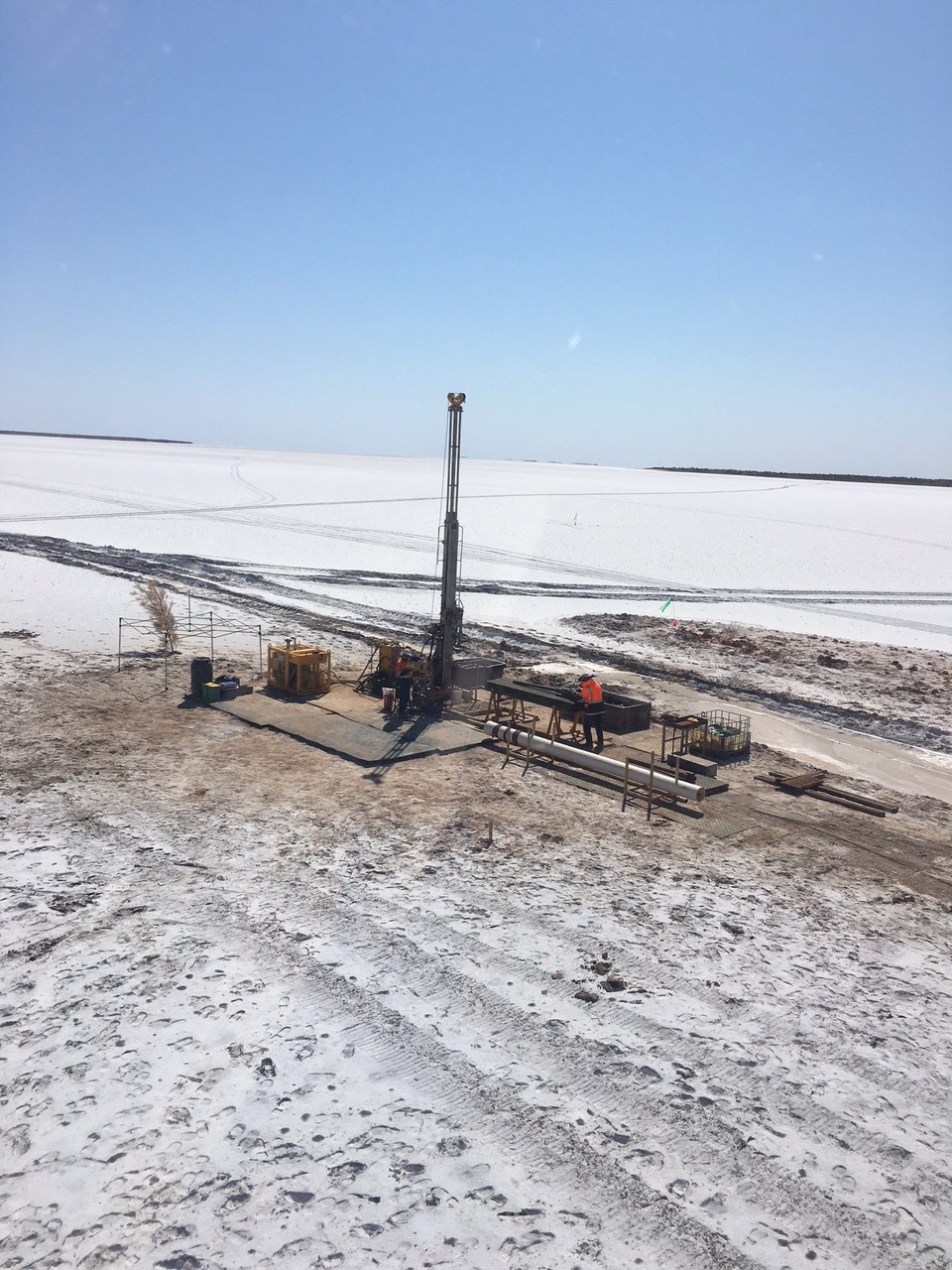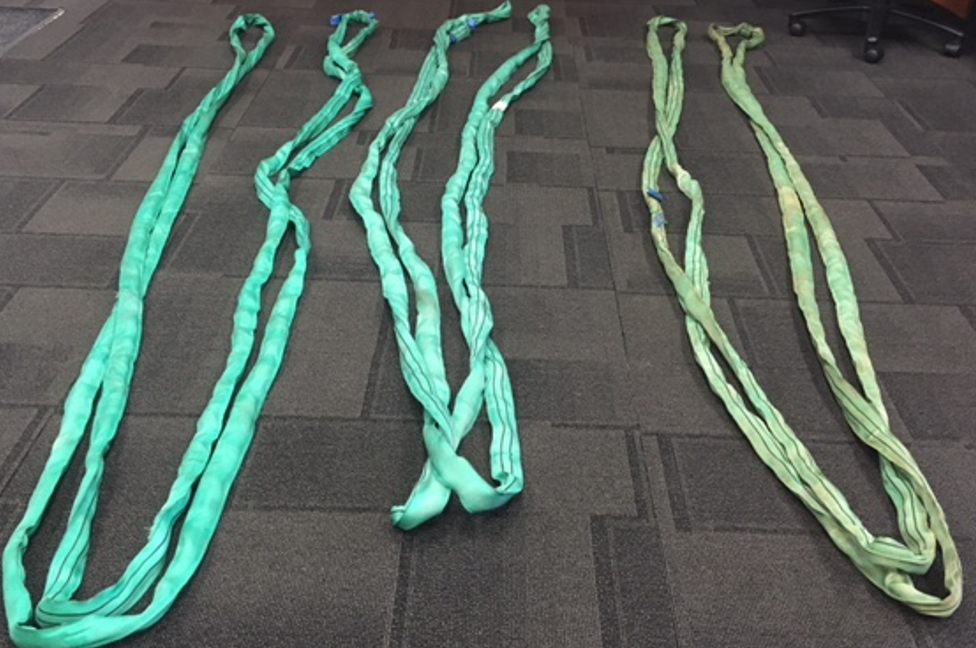On 23 May 2016 at about 0700 Western Standard Time, a team of ground and flight crew commenced sling operations to move a drill rig and associated platform and equipment by helicopter to a new location on a salt lake at Lake Disappointment, Western Australia.
The ground team for the removal of the equipment consisted of a load master and a driller’s offsider. The pilot of an Aerospatiale Industries AS350 helicopter, registered VH-BII, worked with the ground crew to move three mats and a power pack to a new site, before returning to move the rig. The load master and offsider attached the rig to the hook under the helicopter and attached two tag lines – 6 m loop slings, to the load on separate corners. At about 1040, in readiness to lift the rig, the load master advised the pilot using hand signals that the load was attached and that they were clear and ready for the lift.
The helicopter climbed and the rig lifted a few centimetres above the ground. The load swivelled as it lifted off the ground, and pushed against a PVC pipe protruding from a bore hole. The load master and offsider stepped in closer to manoeuvre the rig clear of the pipe.
The pilot observed the ground crew then step away from the rig. As they stepped back, the offsider had inadvertently stepped into the loop of the tag line. As the helicopter lifted the rig, the tag line went taught, and the offsider’s leg was ensnared in the loop. The offsider was lifted off the ground by the leg and the helicopter began lifting the load. The load master radioed the pilot, and advised that the offsider was hanging in the loop.
The helicopter was then about 50–60 ft above the salt lake. The pilot turned the helicopter around to return to the pad and descended to about 15–20 ft above the ground. The pilot also slowed the helicopter as much as possible given the load and the tailwind, to a groundspeed of about 25 kt.
The offsider then freed their leg and was about to jump off, but the helicopter then started to climb and accelerate. The offsider therefore released the tag line and dropped about 10 m into the mud below. The offsider sustained a serious injury.
This incident highlights the importance of conducting a thorough risk analysis prior to commencing operations. The risk assessment should clearly identify hazards and introduce measures that mitigate any associated risks.
What happened
On 23 May 2016 at about 0600 Western Standard Time (WST), a team of ground and flight crew met to discuss the day’s operations to move a drill rig and associated platform and equipment by helicopter to a new location at Lake Disappointment, Western Australia (Figure 1). The rig had been operating on a salt lake and the move involved two helicopters – an Aerospatiale Industries AS350 helicopter, registered VH-BII (BII), to move the rig and heavier equipment, and a smaller helicopter (Robinson R44) to move the smaller, lighter equipment and personnel.
Figure 1: Drilling rig on Lake Disappointment

Source: Ground crew operator
The pilot of BII suggested that the ground crew use tag lines for the operation. These would enable the ground crew to manoeuvre the loads as necessary while the load was off the ground slung under the helicopter. For tag lines, the pilot provided the ground crew with slings – 6 m loops (Figure 2), which they were to attach to the loads that were already encased in other slings ready for moving.
The ground team for the removal of the equipment, consisted of a load master and a driller’s offsider. The driller’s offsider involved in the operation was new to the role. For the operation, the offisider’s role included ground support and to sling equipment under the guidance of the load master. The load master was to guide the helicopter using hand signals and a two-way radio to communicate with the helicopter pilot.
Figure 2: Loop slings

Source: Operator of VH-BII
At about 0700, the pilot of BII commenced sling operations. The pilot worked with the ground crew to move three mats (weighing 550 kg each) and a power pack (770 kg) to a new site, before returning to move the rig (about 700 kg). The pilot positioned the helicopter into wind. The load master and offsider attached the rig to the hook under the helicopter using the slings around the load and four attachment points. They attached two tag lines to the load on separate corners. At about 1040, in readiness to lift the rig, the load master advised the pilot using hand signals that the load was attached and that they were clear and ready for the lift.
The pilot commenced lifting the rig. The helicopter climbed and the rig lifted a few centimetres above the ground. The load swivelled as it lifted off the ground, and pushed against a PVC pipe protruding from a bore hole. The load master and offsider stepped in closer to guide the rig. The load master pushed the rig while the offsider pulled on the tag line to manoeuvre the rig clear of the pipe.
The pilot looked down through a window in the floor of the helicopter beside the seat and observed the ground crew then step away from the rig. The pilot then shifted their attention inside the cockpit to the instruments to monitor power settings and continued with the lift.
As they[1] stepped back, the offsider had inadvertently stepped into the loop of the tag line. As the helicopter lifted the rig, the tag line went taught, and the offsider’s leg was ensnared in the loop. The offsider was lifted off the ground by the leg and the helicopter began lifting the load. The load master radioed the pilot, and advised that the offsider was hanging in the loop.
By the time the pilot became aware that the offsider was caught in the loop, the helicopter was about 50–60 ft above the salt lake. The pilot turned the helicopter around to return to the pad and encountered a tailwind of 8–10 kt. The helicopter overflew mud flats and the pilot descended as low as they felt was safe, which was about 15–20 ft above the ground. The pilot also slowed the helicopter as much as possible given the load and the tailwind, to a groundspeed of about 25 kt.
The offsider then freed their leg and was about to jump off from about 2 m above the ground, but reported that the helicopter then started to climb and accelerate. Now only holding on by their hands, the offsider was concerned that they would not be able to hold on much longer if the helicopter sped up, and that they risked injury from falling further as the helicopter climbed. The offsider therefore released the tag line and dropped into the mud below. The offsider estimated they were about 10 m above the ground when they let go.
The load master ran to assist the offsider. The pilot saw the offsider land in the mud and flew the helicopter to an island nearby and put the rig down. The pilot of the R44 helicopter working on the site picked up the offsider, who was then taken for medical assessment. The offsider sustained a serious injury.
Pilot comments
The pilot later commented that, having become aware that the offsider was ensnared, they had no intention of putting the rig down while the offsider was hanging underneath. The pilot intended to turn the helicopter back around into wind to slow the helicopter sufficiently for the offisider to release themselves back onto the ground, at the pad where they had lifted off.
The ground crew had cautioned each other to be careful of the loop. But with the noise and downwash of the helicopter, watching the rig taking off, and the tag line hanging 4-5 m after the load, the offsider was ensnared.
In future, if a ground crewmember became trapped in a line, the pilot would remain in radio contact with the load master and would not put the load down. They would return as quickly as possible to the site so the load master could assist with the safe release of the offsider.
Driller’s offsider comments
The offsider commented that once they were slung under the helicopter there was no way they could communicate with the pilot or the load master. The offsider did not have a radio. The helicopter was then about 100 m from the pad and too far away to be able to hear or communicate with the load master. Although there was a small window in the floor of the helicopter, the pilot would not have been able to see the offsider hanging as they were below the rig.
The offsider further commented that it was important for the load master, or person in radio communication with the pilot, to ensure all ground personnel were a safe distance from the helicopter before giving the pilot the all clear to lift.
The offsider also commented that use of a sling as a tag line carries increased risk of ensarement. A single or unlooped line would be less hazardous.
Ground crew operations company report
The ground crew operations company conducted an investigation into the incident and identified three contributing factors:
Tag lines to loads were introduced without an associated risk assessment.
The offsider was a new employee and was not fully aware of the hazards.
The load shifted in an unexpected direction, resulting in the ground crew moving back in towards the rig after the load master had given the all clear.
Helicopter operator report
The helicopter operator conducted an investigation into the incident and included the following conclusions:
- The pilot was appropriately qualified, current and proficient.
- The format of the ground crew briefing did not, nor was it required to, include an entanglement response in emergency procedures.
- Tag lines were new equipment on the project and were introduced without a formal risk assessment. There were no formal procedures for the use of tag lines and the risk of entanglement was not identified at the time. The 6 metre loops usually used for lifting loads were not standard tag lines.
- Some improvements could be made with better communication between pilot and ground crew which may require additional training or practice. This may have been a factor in this incident.
- The pilot met the procedural take-off requirement visually ensuring they were clear of the load before lifting started, however, procedures do not identify risk aspects of multiple ground crew operations nor do they take into account the high workload of the pilot at time of lift.
Safety action
Whether or not the ATSB identifies safety issues in the course of an investigation, relevant organisations may proactively initiate safety action in order to reduce their safety risk. The ATSB has been advised of the following safety action in response to this occurrence.
Ground crew operations
As a result of this occurrence, the ground crew operations company has advised the ATSB that they have taken the following safety actions:
- people carrying out slinging operations are to use more appropriate tag lines – 16 mm single strand synthetic rope[2]
- ground crew to undergo Dogging[3] training
- helicopter pilot to visually confirm the load is not entangled prior to moving off
- job hazard analysis to incorporate the use of tag lines
- safe working procedures to take into account visual confirmation that the load is clear
- promotion of ‘take 5 culture’[4] to address hazards as they are identified
- platform scales to weigh rig items have been provided, sling line certification has been conducted and routine condition inspections have been conducted
- UHF radios have been installed.
Helicopter operator
As a result of this occurrence, the operator of BII has advised the ATSB that they have taken the following safety actions:
- Enhanced briefing implemented for client ground crew which includes potential of entanglement and preventative measures as well as roles when there are more than one ground crew member.
- A risk profile has been completed for tag line use.
- Clients are provided with a personal protective equipment list for their personnel involved with ground operations.
Safety message
This incident highlights the importance of conducting a thorough risk analysis prior to commencing operations. The risk assessment should clearly identify hazards and introduce measures that mitigate any associated risks. In addition, it is important to consider possible emergency scenarios and develop procedures to follow in the event of an abnormal situation developing.
Appropriate training is essential for personnel working in complex operations. In addition to individual roles and skills, training should include how team members work together to maintain and improve safety. Part of working together safely involves effective communication and a mutual understanding of phrases and signals.
Purpose of safety investigationsThe objective of a safety investigation is to enhance transport safety. This is done through:
It is not a function of the ATSB to apportion blame or provide a means for determining liability. At the same time, an investigation report must include factual material of sufficient weight to support the analysis and findings. At all times the ATSB endeavours to balance the use of material that could imply adverse comment with the need to properly explain what happened, and why, in a fair and unbiased manner. The ATSB does not investigate for the purpose of taking administrative, regulatory or criminal action. TerminologyAn explanation of terminology used in ATSB investigation reports is available here. This includes terms such as occurrence, contributing factor, other factor that increased risk, and safety issue. Publishing informationReleased in accordance with section 25 of the Transport Safety Investigation Act 2003 Published by: Australian Transport Safety Bureau © Commonwealth of Australia 2016
Ownership of intellectual property rights in this publication Unless otherwise noted, copyright (and any other intellectual property rights, if any) in this report publication is owned by the Commonwealth of Australia. Creative Commons licence With the exception of the Coat of Arms, ATSB logo, and photos and graphics in which a third party holds copyright, this publication is licensed under a Creative Commons Attribution 3.0 Australia licence. Creative Commons Attribution 3.0 Australia Licence is a standard form licence agreement that allows you to copy, distribute, transmit and adapt this publication provided that you attribute the work. The ATSB’s preference is that you attribute this publication (and any material sourced from it) using the following wording: Source: Australian Transport Safety Bureau Copyright in material obtained from other agencies, private individuals or organisations, belongs to those agencies, individuals or organisations. Where you wish to use their material, you will need to contact them directly. |
__________
- Gender-free plural pronouns are used throughout the report to refer to an individual (i.e. they, them and their).
- The helicopter operator commented that the lines are to be weighed and assessed to ensure they do not create an entanglement hazard in flight to the tail or main rotor.
- Use and care of slings and strapping gear, and load movement and crane operations.
- Take 5 culture increases safety awareness by encouraging workers to 5 minutes to assess hazards and implement risk control actions.


